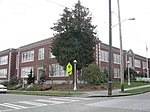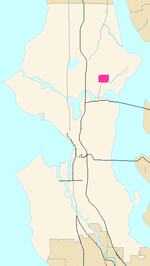The Union Bay Natural Area (UBNA) in Seattle, Washington, also known as Union Bay Marsh, is the restored remainder of the filled former Union Bay and Union Bay Marsh. It is located at the east end of the main University of Washington campus, south of NE 45th Street and west of Laurelhurst. Ravenna Creek is connected to University Slough (Drainage Canal), thence to Union Bay, and Lake Washington. Drainage Canal is one of three or four areas of open water connected with Lake Washington around Union Bay Marsh. The canal extends from NE 45th Street, between the driving range and IMA Sports Field 1, south to the bay, ending southeast of the Husky Ballpark baseball grandstand (northeast of the IMA Building). The Drainage Canal that carries Ravenna Creek past UBNA to Union Bay is locally sometimes called University Slough.
The little grasslands, modest ponds, and lake shoreline of the UBNA is a sanctuary for birds (including double-crested cormorants, great blue herons, and eagles); turtles and frogs may be seen. The UBNA is notable for diverse habitats including a good-sized lake, small permanent ponds, seasonal ponds, woods, sample prairie, and marshland. The interfaces among these make the area particularly attractive for birdwatching, with more than 150 species of birds sighted. The canal or slough was part of a restoration of the wetlands called Union Bay Marsh that had been drained by the opening of the Montlake Cut of the Lake Washington Ship Canal (1916) and much of Union Bay filled by the Montlake Dump, (home of J. P. Patches, resident 1958–1981). Formerly the Montlake Landfill, University Dump, or Ravenna Landfill, it was used by the City of Seattle for residential and industrial solid waste from 1911 to 1966. It was fully closed five years later and overlaid with two feet of clean soil. Most of the land has been built upon by University Village (1956), UW athletic fields, buildings, and main parking lot E; the remainder comprises the UBNA, colloquially called "the fill".
Before the lowering of Lake Washington during the early part of the 20th century, Ravenna and Yesler Creeks flowed into marshland north of where the canal now begins, and the land through which the canal would be cut lay under the waters of Union Bay. The Burke-Gilman Trail follows the Seattle, Lake Shore and Eastern Railway line along the original shoreline of Union Bay past the UW power plant and University Village. Construction was completed in 2006 on a project that reconnects partially daylighted Ravenna Creek to Union Bay by piping it underground to the canal, thus converting the upper reach from a relatively stagnant drainage to the outlet for one of Seattle's partially restored urban creeks. Daylighting from southeast Ravenna Park to the UW and the UBNA has been blocked by the owners of University VillageThe UBNA is owned by the State of Washington and held under the aegis of the University of Washington; access is controlled. Parts of the Area are open during park hours, access to other portions is discouraged, some portions seasonally, for habitat or species protection.Many restoration projects take place at UBNA. Removal of invasive species, such as Himalayan blackberry (Rubus armeniacus) and morning glory (Convolvulus arvensis), are part of a continual effort to restore the site to a natural area. Volunteers account for much of the progress in the Union Bay Natural Area.









